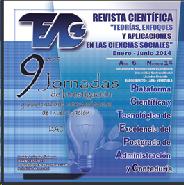Facebook® as a tool for communication in education: uses and potential to promote collaborative learning. Case: agroindustrial engineering students
Keywords:
social networking, web 2.0, facebook, distance learning, collaborative learningAbstract
Information and communication technologies are changing the world, they have also revolutionized education. Social networks for educational purposes are a challenge for teachers regarding new curriculum guidelines which require different learning scenarios. The present research demonstrates a collaborative learning experience among teachers and students from Agribusiness Engineering undergraduate program, taking Introduction to Computing and ICT Elective and Technology Management subject at UCLA. We endorse that the research was based on the use and potential social networks allow us today, especially the second most used worldwide network known as Facebook. It was also used to create a group to organize working committees of the First Conference on ICT and Management technology. With a simulation technique of participant observation, monitoring and a survey in order to measure the level of satisfaction, the results reflect the acceptance of experience, and the way they should be used properly to maximize resources. That requires training and lifelong learning.
Downloads
References
Cobo Romaní, C.; Pardo Kuklinski, H. (2007). Planeta Web 2.0. Inteligencia colectiva o medios fast food. [en línea]. Grup de Recerca d'Interaccions Digitals, Universitat de Vic. Flasco México. Barcelona / México DF. E-book de acceso gratuito. Versión 0.1 /Septiembre de 2007. Web oficial del libro: http://www.planetaweb2.net/ (Consultado el 20-01-2008).
Facebook (2009). Declaración de Derechos y Responsabilidades. Fuente: http://es-la.facebook.com/terms.php?ref=pf . (Consultado el 28-02-2010).
Facebook (2013). Sala de Prensa. Datos Estadísticos. Fuente: http://www.facebook.com/press/info.php?statistics. (Consultado el 26-06-2013).
Fumero, A. y Roca, G. (2007). Web 2.0 [en línea]. Fundación Orange España. Fuente: http://www.fundacionauna.com/areas/25_publicaciones/WEB_DEF_COMPLETO.pdf (Consultado el 26-06-2013).
Handley, C.; Wilson, A.; Peterson, N.; Brown, G.; Ptzaszynksi, J. (2007). Out of the Classroom & Into the Boardroom. Higher Ed Consortium, Microsoft [en línea] http://www.microsoft.com/presspass/events/educause/docs/EducauseWhitepaper.pdf (Consultado el 12-06-2013).
Hornung-Prähauser, V.; Luckmann, M. & Kalz, M. (Eds.) (2008). Selbstorganisiertes Lernen im Internet. Einblick in die Landschaft der webbasierten Bildungsinnovationen. Innsbruck: Studienverlag.
Kirchman, D. (2010) Las redes sociales buscan un lugar en la educación. Fuente: http://www.rionegro.com.ar/diario/2010/027081265597144216.php. (Consultado el 08-02-2012).
Martín-Moreno Cerrillo, Q. (2004): Aprendizaje colaborativo y redes de conocimiento. Libro de actas de las IX Jornadas Andaluzas de Organización y Dirección de Instituciones Educativas. Granada, 15-17 de diciembre de 2004. Grupo Editorial Universitario, pp. 55-70.
Münch, L. y Angeles, E. (2001). Métodos y técnicas de investigación. Ediciones Trillas. México.
Nafría, I. (2007): Web 2.0, El usuario es el rey. Barcelona: Ediciones Gestión 2000, Planeta de Agostini. · O'Reilly, T. (2005): What Is Web 2.0. Fuente: http://www.oreillynet.com/pub/a/oreilly/tim/news/2005/09/30/what-is-web-20.html (Consultado el 28-04-2012).
Phillips, S. (2007). A Brief History of Facebook. Fuente: http://www.guardian.co.uk/technology/2007/jul/25/media.newmedia. (Consultado el 08-12-2009).
Rivero, M. (2010) Integración de las TIC a la educación. Fuente: http://www.lanacion.cl/integracion-de-las-tic-a-laeducacion/noticias/2010-01-07/003900.html. (Consultado el 11-01-2010).
Selwyn, N. (2007). Web 2.0 applications as alternative environments for informal learning - a critical review. [en línea]. Paper for OECD-KERIS expert meeting. Fuente: http://www.oecd.org/dataoecd/32/3/39458556.pdf. (Consultado el 15-07-2011).
Published
How to Cite
Issue
Section
Derechos del/de autor/es a partir del año de publicación
Esta obra está bajo la licencia:
Creative Commons Reconocimiento-NoComercial-CompartirIgual 4.0 Internacional (CC BY-NC-SA 4.0)
Las opiniones expresadas por los autores no necesariamente reflejan la postura del editor de la publicación ni de la UCLA. Se autoriza la reproducción total o parcial de los textos aquí publicados, siempre y cuando se cite la fuente completa y la dirección electrónica de esta revista. Los autores(as) tienen el derecho de utilizar sus artículos para cualquier propósito siempre y cuando se realice sin fines de lucro. Los autores(as) pueden publicar en internet o cualquier otro medio la versión final aprobada de su trabajo, luego que esta ha sido publicada en esta revista.



